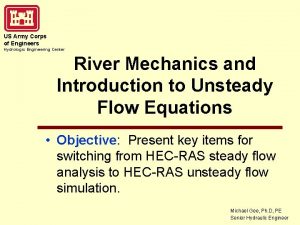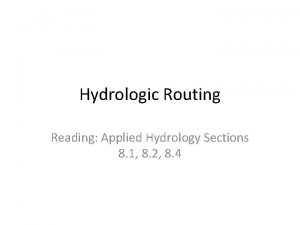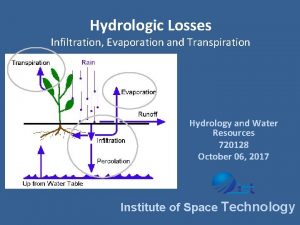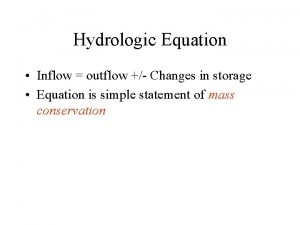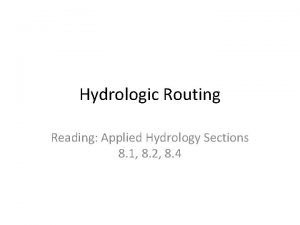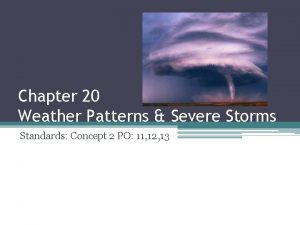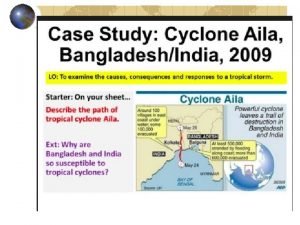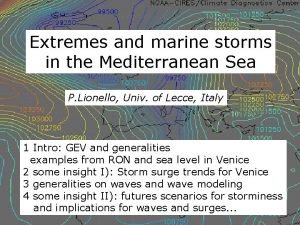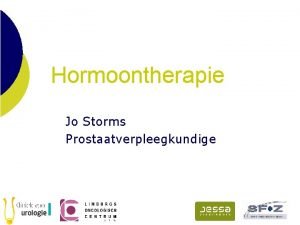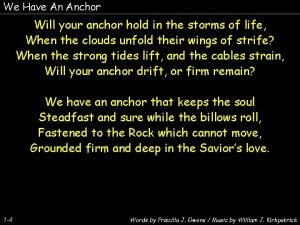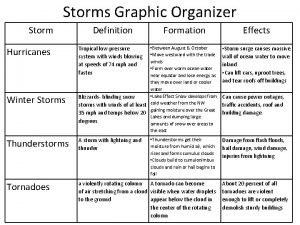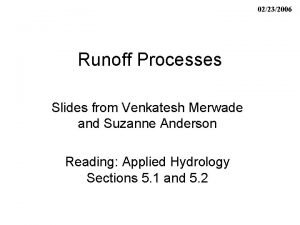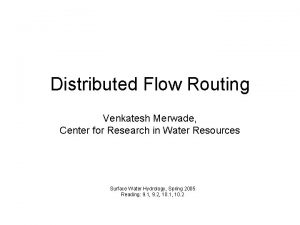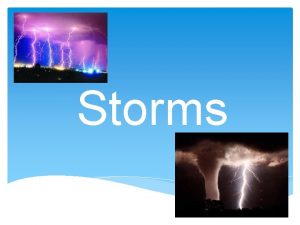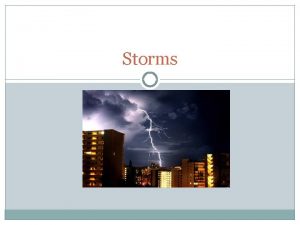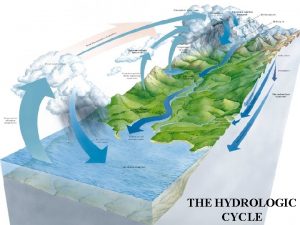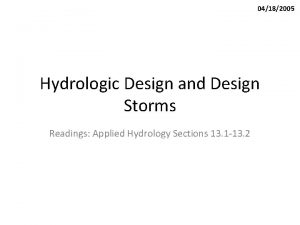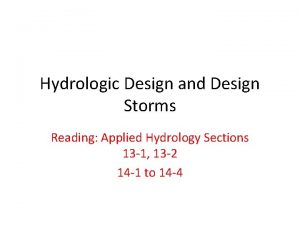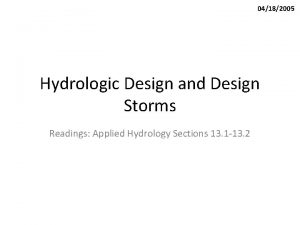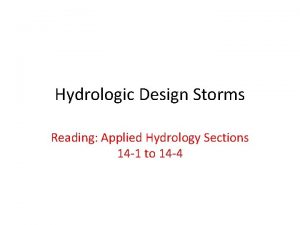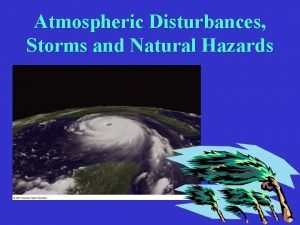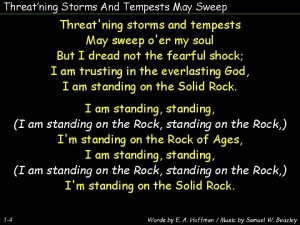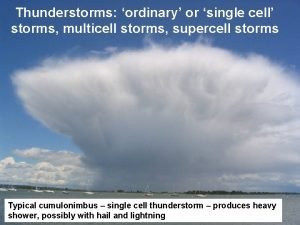Hydrologic Design and Design Storms Venkatesh Merwade School


























- Slides: 26

Hydrologic Design and Design Storms Venkatesh Merwade, School of Civil Engineering, Purdue University Some slides are taken from Dr. David Maidment, University of Texas at Austin

Hydrologic Cycle

Rainfall Hyetograph www. mem. odu. edu

Rainfall Hyetograph and Mass Curve

Rainfall hyetograph creates a discharge hydrograph at the receiving detention pond or stream or storm water treatment facility

Hydrographs

Hydrologic design • Water control – Peak flows, erosion, pollution, etc. • Water management – Domestic and industrial use, irrigation, instream flows, etc • Tasks – Determine design inflow – Route the design inflow – Find the output • check if it is sufficient to meet the demands (for management) • Check if the outflow is at safe level (for control) 7

Design Basis

Frequency and Recurrence Interval • Small storm versus big storm • Recurrence Interval: number of years of data divided by the number of occurrences

Return Period (T) • Average recurrence interval over an extended period of time • Probability of occurrence = 1/T • 100 year flow (Q 100) will have a 1% chance of occurrence every year

11

Design Storms • Get Depth, Duration, Frequency Data for the required location • Select a return period • Convert Depth-Duration data to a design hyetograph.

Depth Duration Data to Rainfall Hyetograph

Depth (intensity)-duration-frequency • DDF/IDF – graph of depth (intensity) versus duration for different frequencies – TP 40 or HYDRO 35 gives spatial distribution of rainfall depths for a given duration and frequency – DDF/IDF curve gives depths for different durations and frequencies at a particular location – TP 40 or HYDRO 35 can be used to develop DDF/IDF curves • Depth (P) = intensity (i) x duration (Td) 14

IDF curve 15

TP 40 • Hershfield (1961) developed isohyetal maps of design rainfall and published in TP 40. • TP 40 – U. S. Weather Bureau technical paper no. 40. Also called precipitation frequency atlas maps or precipitation atlas of the United States. – 30 mins to 24 hr maps for T = 1 to 100 • Web resources for TP 40 and rainfall frequency maps – http: //www. tucson. ars. ag. gov/agwa/rainfall_frequency. ht ml – http: //www. erh. noaa. gov/er/hq/Tp 40 s. htm – http: //hdsc. nws. noaa. gov/hdsc/pfds/ 16

2 yr-60 min precipitation map This map is from HYDRO 35 (another publication from NWS) which supersedes TP 40 17

2 yr-60 min precipitation GIS map 18

Equations for IDF curves can also be expressed as equations to avoid reading from graphs i is precipitation intensity, Td is the duration, and c, e, f are coefficients that vary for locations and different return periods This equation includes return period (T) and has an extra coefficient (m) 19

IDF curves for Austin Source: City of Austin, Watershed Management Division 20

Design Precipitation Hyetographs • • Most often hydrologists are interested in precipitation hyetographs and not just the peak estimates. Techniques for developing design precipitation hyetographs 1. SCS method 2. Triangular hyetograph method 3. Using IDF relationships (Alternating block method) 21

SCS Method n. SCS (1973) adopted method similar to DDF to develop dimensionless rainfall temporal patterns called type curves for four different regions in the US. n. SCS type curves are in the form of percentage mass (cumulative) curves based on 24 -hr rainfall of the desired frequency. n. If a single precipitation depth of desired frequency is known, the SCS type curve is rescaled (multiplied by the known number) to get the time distribution. n. For durations less than 24 hr, the steepest part of the type curve for required duraction is used 22

SCS type curves for Indiana (Type II) SCS 24 -Hour Rainfall Distributions T (hrs) SCS 24 -Hour Rainfall Distributions Fraction of 24 -hr rainfall Type II T (hrs) Type III Fraction of 24 -hr rainfall Type III 0. 000 11. 5 0. 283 0. 298 1. 0 0. 011 0. 010 11. 8 0. 357 0. 339 2. 0 0. 022 0. 020 12. 0 0. 663 0. 500 3. 0 0. 034 0. 031 12. 5 0. 735 0. 702 4. 0 0. 048 0. 043 13. 0 0. 772 0. 751 5. 0 0. 063 0. 057 13. 5 0. 799 0. 785 6. 0 0. 080 0. 072 14. 0 0. 820 0. 811 7. 0 0. 098 0. 089 15. 0 0. 854 8. 0 0. 120 0. 115 16. 0 0. 886 8. 5 0. 133 0. 130 17. 0 0. 903 0. 910 9. 0 0. 147 0. 148 18. 0 0. 922 0. 928 9. 5 0. 163 0. 167 19. 0 0. 938 0. 943 9. 8 0. 172 0. 178 20. 0 0. 952 0. 957 10. 0 0. 181 0. 189 21. 0 0. 964 0. 969 10. 5 0. 204 0. 216 22. 0 0. 976 0. 981 11. 0 0. 235 0. 250 23. 0 0. 988 0. 991 24. 0 1. 000 23

SCS Method Steps • Given Td and frequency/T, find the design hyetograph 1. Compute P/i (from DDF/IDF curves or equations) 2. Pick a SCS type curve based on the location 3. If Td = 24 hour, multiply (rescale) the type curve with P to get the design mass curve 1. If Td is less than 24 hr, pick the steepest part of the type curve for rescaling 4. Get the incremental precipitation from the rescaled mass curve to develop the design hyetograph 24

http: //hdsc. nws. noaa. gov/hdsc/pfds/index. html

Indiana Resources http: //www. in. gov/dnr/water/4897. htm
 Venkatesh sridhar
Venkatesh sridhar Meera venkatesh
Meera venkatesh Hydrologic continuity equation
Hydrologic continuity equation Hyetograph example
Hyetograph example Hydrologic engineering center
Hydrologic engineering center Flood routing
Flood routing Hydrologic routing
Hydrologic routing Infiltration
Infiltration Hydrologic equation
Hydrologic equation Hydrologic abstractions
Hydrologic abstractions Objectiveable
Objectiveable Continuity equation hydraulics
Continuity equation hydraulics Hydrologic engineering center
Hydrologic engineering center Water cycle the hydrologic cycle
Water cycle the hydrologic cycle Lumped flow routing
Lumped flow routing River analysis system
River analysis system Hydrologic engineering center
Hydrologic engineering center Chapter 20 weather patterns and severe storms
Chapter 20 weather patterns and severe storms Chapter 20 weather patterns and severe storms
Chapter 20 weather patterns and severe storms Describe the global distribution of tropical storms
Describe the global distribution of tropical storms Egyptian god of storms
Egyptian god of storms Storms in the mediterranean sea
Storms in the mediterranean sea Egyptian god of storms
Egyptian god of storms Bill nye severe weather
Bill nye severe weather Jo storms
Jo storms Fastened to the rock which cannot move
Fastened to the rock which cannot move Tornado graphic organizer
Tornado graphic organizer




